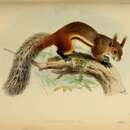fi
nimet breadcrumb-navigoinnissa


Perception Channels: tactile ; chemical
Other Physical Features: endothermic ; bilateral symmetry
Key Reproductive Features: gonochoric/gonochoristic/dioecious (sexes separate); sexual
The Anomaluridae are a family of rodents found in central Africa.[2] They are known as anomalures or scaly-tailed squirrels. The six extant species are classified into two genera.
All anomalurids have membranes between their front and hind legs like those of a flying squirrel, but they are not closely related to the flying squirrels that form the tribe Petauristini of the family Sciuridae. They are distinguished by two rows of pointed, raised scales on the undersides of their tails.[3] The anatomy of their heads is quite different from that of the sciurid flying squirrels.
By extending their limbs, anomalures transform themselves into a gliding platform that they control by manipulating the membranes and tail.[4]
Most anomalurid species roost during the day in hollow trees, with up to several dozen animals per tree. They are primarily herbivorous, and may travel up to 6 km (3.7 mi) from their roosting tree in search of leaves, flowers, or fruit, although they also eat a small amount of insects. They give birth to litters up to three young, which are born already furred and active.[3]
Anomalurids represent one of several independent evolutions of gliding ability in mammals, having evolved from climbing animals.[5][6] The others include the true flying squirrels of Eurasia and North America, colugos or flying lemurs of Southeast Asia, and the marsupial gliding possums of Australia.
Taxonomy follows Fabre et al. 2018.[7][8]
Several fossil genera are also known:
The Anomaluridae are a family of rodents found in central Africa. They are known as anomalures or scaly-tailed squirrels. The six extant species are classified into two genera.
All anomalurids have membranes between their front and hind legs like those of a flying squirrel, but they are not closely related to the flying squirrels that form the tribe Petauristini of the family Sciuridae. They are distinguished by two rows of pointed, raised scales on the undersides of their tails. The anatomy of their heads is quite different from that of the sciurid flying squirrels.
By extending their limbs, anomalures transform themselves into a gliding platform that they control by manipulating the membranes and tail.
Most anomalurid species roost during the day in hollow trees, with up to several dozen animals per tree. They are primarily herbivorous, and may travel up to 6 km (3.7 mi) from their roosting tree in search of leaves, flowers, or fruit, although they also eat a small amount of insects. They give birth to litters up to three young, which are born already furred and active.
Anomalurids represent one of several independent evolutions of gliding ability in mammals, having evolved from climbing animals. The others include the true flying squirrels of Eurasia and North America, colugos or flying lemurs of Southeast Asia, and the marsupial gliding possums of Australia.